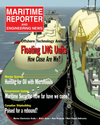
Page 40: of Maritime Reporter Magazine (April 2005)
The Offshore Industry Anual
Read this page in Pdf, Flash or Html5 edition of April 2005 Maritime Reporter Magazine
40 Maritime Reporter & Engineering News
Offshore Technology Annual also be generated by recording data as the well is drilled. The MMS has about 300,000 logs from 44,000 wells in the Gulf of Mexico.
Logging tools can measure the temperature, electric potential, density, radioactivity, velocity, resistivity, and conductivity of the rock formations they encounter. These measurements are used to determine the petrophysical characteristics - porosity, permeabil- ity, and water and hydrocarbon saturation - directly related to the oil and gas producing potential of the rock. These evaluations are necessary not only to iden- tify the rock type and hydrocarbon-bearing reservoirs but also to identify the type of hydrocarbon (i.e., gas, oil, condensate), and to determine the volume of hydrocarbons in place and the volume of hydrocarbons that can be successfully extracted from a reservoir.
Detailed petrophysical analysis is a vital and necessary step in the explo- ration for the development of oil and gas prospects.
Paleontology also provides the geo- scientist with tools to use in the hunt for hydrocarbons. The study of microfossils by paleontologists pro- vides additional clues to the geologic history of a hydrocarbon prospect.
The type of fossils found in a poten- tial field can help scientists determine the age and depositional environment of the strata or structure being explored. Today's geoscientists use many tools in the exploration for hydrocarbons beneath the seafloor.
Each tool provides its own unique insights into the sub- surface. As technology advances, refinements are made and more advanced tools are developed. The result is a more accurate and cost-effective means of oil and gas exploration. (Reproduced, with permission, from the January/February 2005 edition of Ocean Science, Volume 2, Issue 1, a publica- tion of the Minerals Management Service)
Minerals Management Service's (MMS) public lease sale on the
Outer Continental Shelf (OCS) is just a part of MMS' efforts to manage natural energy resources. The GOM OCS Region is divided into thousands of three- by three-mile blocks. Twice a year at scheduled, public lease sales, interested oil and gas companies submit sealed bids for each nine-square-mile block they wish to lease. Bids for each block are announced and the highest bid noted. It is then that MMS's Resource Evaluation team must determine whether the fair market value is reflect- ed in the highest bid. In 2004, MMS evaluated bids on 908 tracts in the Gulf of Mexico (GOM).
Circle 304 on Reader Service Card
MR APRIL 2005 #5 (33-40).qxd 4/4/2005 3:26 PM Page 8

 39
39

 41
41
